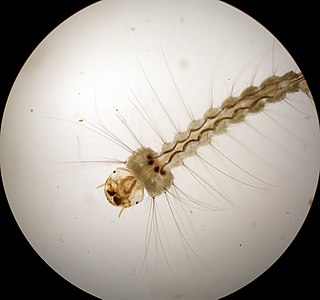Related Research Articles
Aedes apicoargenteus is an African mosquito species, first described as Stegomyia apicoargentea from specimens collected in Ashanti, Ghana.
Aedes vittatus is a species of mosquito that was first described in 1861 as Culex vittatus from specimens collected on Corsica. In 2000, the species was transferred to the newly erected subgenus Fredwardsius as the type species representing the subgenus.
Aedes furcifer was named in 1913 as a nomen novum for nigra (Theobald). Aedes furcifer and Aedes taylori have been treated as two species, usually found sympatrically, but are difficult to separate morphologically so the term "Aedes furcifer-taylori group" has been used for the two species, and they have not always been differentiated by workers conducting studies on them.
Aedes luteocephalus is an African species that is a demonstrated or suspected vector of several important arboviral diseases of humans. First described in 1907 as Stegomyia luteocephala, the species is currently classified in the genus Aedes, subgenus Stegomyia.
Aedes hoogstraali is a species of mosquito. It was first described from specimens collected at Subic Bay, Republic of the Philippines in 1945. The specific epithet honors noted entomologist and acarologist Harry Hoogstraal.
Aedes malayensis was first described in 1963 by Australian entomologist Donald Henry Colless as a subspecies of Aedes scutellaris from males collected at Pulau Hantu, Keppel Harbor, Singapore. In 1972 the subspecies was elevated to species status by Yiau-Min Huang, although the move was disputed by the original describer on biological as opposed to morphological principles.

Coquillettidia is a mosquito genus erected by entomologist Harrison Gray Dyar Jr. in 1904 based primarily on unique features of its "peculiar" male genitalia. The specific epithet honors Dyar's colleague Daniel William Coquillett.
Haemogogus clarki is an arboreal mosquito native to southern Central America and northern South America. It is deep brown in color with conspicuous patterns of silver scales on the scutum and pleuron. The specific epithet honors Dr. Herbert C. Clark, former Director of the Gorgas Memorial Laboratory.
Haemagogus soperi is a species of mosquito found in the coastal plain region of Ecuador. The specific epithet honors Dr. Frederick Lowe Soper.
Aedes cordellieri is a sub-Saharan African species of mosquito suspected of being a vector of yellow fever. The species name honors Dr. Roger Cordellier, a former medical entomologist with Office de la Recherche Scientifique et Technique Outre-Mer (ORSTOM) in Ivory Coast, in recognition of his contributions to the knowledge of the mosquito fauna of Africa.
Culex perfuscus is the only Culex species mosquito currently implicated as a possible vector of Zika virus. The species type was described in 1914 from Port Herald, Nyasaland by entomologist Frederick Wallace Edwards.
The Afrotropical mosquito genus Eretmapodites contains species that exhibit facultative cannibalism in their larval developmental stages. The species was first described in 1901 by Frederick Vincent Theobald. The type species is Eretmapodites quinquevittatus Theobald
The subgenus Kerteszia are Neotropical anopheline mosquitoes originally described in 1905 by Frederick V. Theobald as genus Kertészia with Kertészia boliviensis as the type species.
Sabethes mosquitoes are primarily an arboreal genus, breeding in plant cavities. The type species is Sabethes locuples, first described by Jean-Baptiste Robineau-Desvoidy in 1827.
Sabethes lutzii is a species name designated a "nomen dubium" i.e., a "dubious name," for a mosquito specimen that remains insufficiently evidenced to be accepted as a proved species.

Aedes koreicus is a mosquito species originally described from Korea that has been shown to be enzootic to Japan, northeastern China, the Republic of Korea, parts of Russia, but recently found in Belgium, Italy, Germany, Hungary, Slovenia, Switzerland and Kazakhstan. Adult Aedes koreicus are relatively large, with areas of white scales on black background, strongly resembling Aedes japonicus, which has also become established outside its native range.
Lutzia shinonagai was first described in 1979. The genus name was originally spelled Lützia; the species name honors medical entomologist Dr. Satoshi Shinonaga who has published extensively on the taxonomy of the muscid, sarcophagid and calliphorid flies of Japan and the Oriental Region. Lutzia shinonagai is the only species in the subgenus Insulalutzia.
Lutzia fuscana is a mosquito that is predatory in its larval stages. It has been investigated as a possible biological control agent, showing some promise where vector species share limited or specific breeding habitat.

Wyeomyia is a genus of mosquitoes first described in 1901 by Frederick Vincent Theobald. The genus's 140 species can be difficult to characterize because of their diversity and the need for additional taxonomic work to further delineate them. Adults resemble genus Limatus and Sabethes mosquitoes more closely than other genera in the New World tribe Sabethini, but differ by their scutal scales ranging in color from a relatively dull bronzy with a slight metallic sheen in most species, to a metallic gold. There are other distinguishing characters as well.
Anopheles nuneztovari is a species of mosquito in the order Diptera native to South America. The species was named by its discoverer, Arnoldo Gabaldón, to honor the Venezuelan entomologist Manuel Núñez Tovar.
References
- ↑ Frederick V. Theobald. 1903. A monograph of Culicidae or mosquitoes, III. London: British Museum (Natural History). xv + 359pp.; 155; http://www.mosquitocatalog.org/files/pdfs/131700-8.Pdf Archived 2016-03-25 at the Wayback Machine .
- 1 2 Thomas V. Gaffigan, Richard C. Wilkerson, James E. Pecor, Judith A. Stoffer and Thomas Anderson. 2016a. "Lutzia" in Systematic Catalog of Culicidae, Walter Reed Biosystematics Unit, http://wrbu.si.edu/generapages/lutzia.htm Archived 2016-03-04 at the Wayback Machine , accessed 21 Feb 2016.
- ↑ Thomas V. Gaffigan, Richard C. Wilkerson, James E. Pecor, Judith A. Stoffer and Thomas Anderson. 2016b. "Genus Lutzia Theobald" in Systematic Catalog of Culicidae, Walter Reed Biosystematics Unit, http://www.mosquitocatalog.org/taxon_descr.aspx?ID=38, accessed 21 Feb 2016.
- ↑ Pradya Somboon and Ralph E Harbach. 2019. Lutzia (Metalutzia) chiangmaiensis n. sp. (Diptera: Culicidae), Formal Name for the Chiang Mai (CM) Form of the Genus Lutzia in Thailand. Journal of Medical Entomology , tjz072, https://doi.org/10.1093/jme/tjz072, published 30 May 2019.